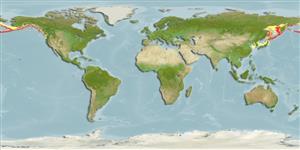Environment: milieu / climate zone / depth range / distribution range
Écologie
marin démersal; profondeur 20 - 1005 m (Ref. 50550), usually 400 - 600 m (Ref. 56390). Temperate
North Pacific: Hokkaido, Japan and Navarin Canyon in the Bering Sea to the Aleutian chain and the Gulf of Alaska.
Taille / Poids / Âge
Maturity: Lm ? range ? - ? cm
Max length : 21.1 cm TL mâle / non sexé; (Ref. 56390); poids max. publié: 80.00 g (Ref. 56395); âge max. reporté: 9 années (Ref. 56390)
Épines dorsales (Total): 7 - 8; Rayons mous dorsaux (Total): 23-24; Épines anales 0; Rayons mous anaux: 18 - 21. Body scales with serrated margin posteriorly; usually the ventral scale row present (Ref. 559). Infraorbital and nuchal spines strong; the uppermost spine of preoperculum bifid or trifid (Ref. 559). Enlarged pores along ventral margin of infraorbitals (Ref. 559). Nostril tube black (Ref. 559).
Life cycle and mating behavior
Maturité | Reproduction | Frai | Œufs | Fécondité | Larves
Masuda, H., K. Amaoka, C. Araga, T. Uyeno and T. Yoshino, 1984. The fishes of the Japanese Archipelago. Vol. 1. Tokai University Press, Tokyo, Japan. 437 p. (text). (Ref. 559)
Statut dans la liste rouge de l'IUCN (Ref. 130435)
Menace pour l'homme
Harmless
Utilisations par l'homme
Pêcheries: sans intérêt
Plus d'informations
RéférencesAquacultureProfil d'aquacultureSouchesGénétiqueElectrophoresesHéritabilitéPathologiesTraitementNutrientsMass conversion
CollaborateursImagesStamps, Coins Misc.SonsCiguateraVitesseType de nageSurface branchialeOtolithesCerveauxVision
Outils
Articles particuliers
Télécharger en XML
Sources Internet
Estimates based on models
Preferred temperature (Ref.
123201): 1.4 - 3.6, mean 2 °C (based on 77 cells).
Phylogenetic diversity index (Ref.
82804): PD
50 = 0.5000 [Uniqueness, from 0.5 = low to 2.0 = high].
Bayesian length-weight: a=0.00676 (0.00300 - 0.01523), b=3.17 (2.98 - 3.36), in cm total length, based on LWR estimates for this (Sub)family-body shape (Ref.
93245).
Niveau trophique (Ref.
69278): 3.5 ±0.4 se; based on diet studies.
Résilience (Ref.
120179): Milieu, temps minimum de doublement de population : 1,4 à 4,4 années (Preliminary K or Fecundity.).
Fishing Vulnerability (Ref.
59153): Low vulnerability (11 of 100).
